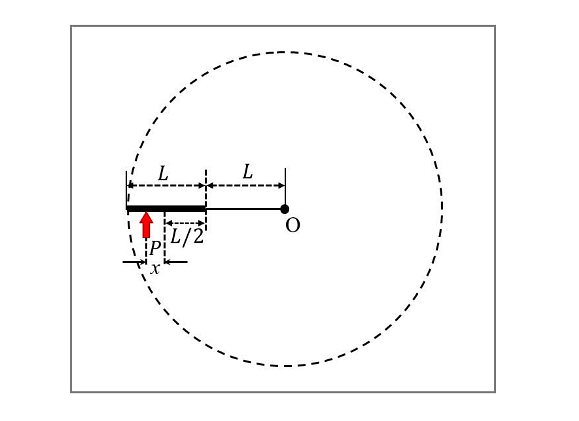A solid cylinder is placed gently over an incline plane of inclination \(60°\). The acceleration of cylinder when it start rolling without slipping is \(\frac{g}{\sqrt x}\) where \(μ\) is the coefficient of friction. [take \(g\) = \(10\;m / (s ^ 2)\) ]


Solution and Explanation
\(Acceleration \;of \;cylinder\):
\(a=\frac{g\frac{\sqrt3}{2}}{\frac{3}{2}}\)
\(=\frac{g}{\sqrt3}\)
The Correct Answer is : \(\frac{g}{\sqrt3}\)
Top Questions on Friction
- A box of mass 20 𝑘𝑔 is pulled at constant speed across a floor by a rope. The rope makes an angle of 45° with the horizontal. Assuming that friction is negligible, the work done in pulling the box by a distance of 20 𝑚 is _____ 𝐽 (rounded off to the nearest integer). (Use $𝑔 = 9.8 𝑚𝑠^{−2}$)
- A horizontal force 10 N is applied to a block 4 as shown in figure. The mass of blocks A and B are 2 kg and 3 kg, respectively. The blocks slide over a frictionless surface. The force exerted by block A on block B is:
- A thin uniform rod of length L and certain mass is kept on a frictionless horizontal table with a massless string of length L fixed to one end (top view is shown in the figure). The other end of the string is pivoted to a point O. If a horizontal impulse P is imparted to the rod at a distance x = L/n from the mid-point of the rod (see figure), then the rod and string revolve together around the point O, with the rod remaining aligned with the string. In such a case, the value of n is _____.

- A body of mass \(100\) kg traveled \(10\) m before coming to rest. If \(µ\) = \(0.4\), work done against friction is - (motion is happening in a horizontal surface, tak \(g\) = \(10\) \(m/s^2\))
- A block of mass \(2\) \(kg\) is placed on a disc which is rotating at constant angular velocity \(4\) \(rad/sec\). Find the friction force in (N) between block and disc if block is not sliding.
Questions Asked in JEE Main exam
- Find the acceleration of \(2\) \(kg\) block shown in the diagram (neglect friction)

- JEE Main - 2024
- Acceleration
- If \(|2A|^3 =21\) and \(\begin{bmatrix} 1 & 0 & 0 \\[0.3em] 0 & α & β \\[0.3em] 0 & β & α \end{bmatrix}\), then a is (if \(α,β∈I\))
- JEE Main - 2024
- Matrices
- Let \(α\) and \(β\) the roots of equation \(px^2 + qx - r = 0\), where \(P≠ 0\). If \(p,q,r\) be the consecutive term of non constant G.P and \(\frac{1}{α} + \frac{1}{β} = \frac{3}{4}\) then the value of \((α - β)^2\) is:
- JEE Main - 2024
- Geometric Progression
- Two lines \(L_1 \;\& \;L_2\) passing through origin trisecting the line segment intercepted by the line \(4x + 5y = 20\) between the coordinate axes. Then the tangent of angle between the lines \(L_1\) and \(L_2\) is
- JEE Main - 2024
- Tangents and Normals
- Rank of the word 'GTWENTY' in dictionary is _____ .
- JEE Main - 2024
- permutations and combinations
Concepts Used:
Friction
Friction is defined as the resistance offered by the surfaces that are in contact when they move past each other.
Types of Friction
There are four categories of Friction- static friction, sliding friction, rolling friction, and fluid friction.
Sliding Friction
In Sliding Friction, the weight of the sliding object calculates the amount of sliding friction present between the two objects. The sliding friction is supposed to be greater as the pressure exerted by the heavy object on the surface it slides over is comparably more.
Rolling Friction
Friction between a circular object and the surface is called as Rolling Friction. It is required to overcome sliding friction is more than the force required to overcome the rolling friction.
Static Friction
Friction that keeps an object at rest without initiating any relative motion between the body and the surface is termed as Static Friction. For example, a parked car resting on the hill, a hanging towel on the rack. The maximum force of static friction is directly proportional to the normal force.
Fluid Friction
Fluid Friction is the kind of friction that is exerted by the fluid on the object that is moving through a fluid.



